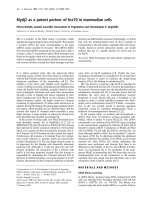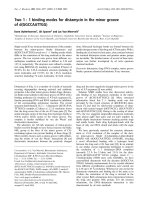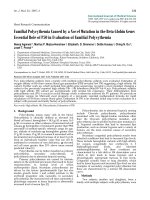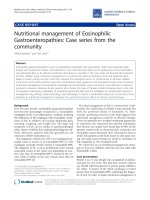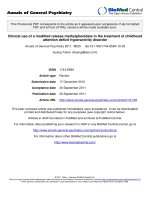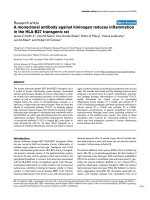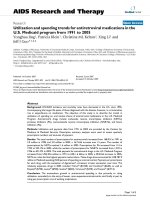Báo cáo y học: "Atrial fibrillation is not just an artefact in the ICU" doc
Bạn đang xem bản rút gọn của tài liệu. Xem và tải ngay bản đầy đủ của tài liệu tại đây (119.24 KB, 2 trang )
Atrial fi brillation (AF) onset in the intensive care unit
(ICU) is attracting widespread attention because of its
frequency and prognostic signifi cance. In the previous
issue of Critical Care, Meierhenrich and colleagues
complete the description of new-onset AF in the ICU in a
selected population of patients suff ering from septic
shock [1]. ey found that 46% of their patients
developed AF and this arrhythmia was signifi cantly
associated with increased ICU length of stay without
aff ecting mortality. Interestingly, they reported a signifi -
cant and continuous increase in C-reactive protein levels
the days before the occurrence of AF, corroborating
previous fi ndings on the hypothesis of an infl ammatory
substrate in AF onset [2].
AF is the most signifi cant arrhythmia in the ICU. e
risk to develop AF in the ICU is largely superior to that of
the general population but diff ers with regard to the type
of ICU involved. Indeed, the risk is estimated to be 4% in
the general population, from 4 to 9% in the general ICU
and an incidence of 32% has been recently reported in a
cardiac surgical ICU [3-9].
How could we explain such a diff erence? In fact, AF is
considered both a cardiac disease and a noncardiac
disease. Age, essential hypertension, ischaemic heart
failure and valvular heart disease are well recognized as
cardiac components of AF, and on the contrary infl am-
mation, whatever its origin, is now considered an impor-
tant noncardiac trigger [4]. In this context, it is not
surprising that cardiac surgery generates a higher
incidence of AF, and several data support this assump-
tion. Eff ectively, in cardiac surgery the risk of AF is
common in the fi rst 3 post operative days and a strength
correlation has been found between various infl amma-
tory parameters and post operative arrhythmia [7,10]. In a
prospective double-blind study, 236 patients undergoing
elective heart surgery were randomized to receive placebo
or dexa metha sone after the induction of anaesthesia.
Patients who received dexamethasone had signifi cantly
less new-onset AF in the 3 postoperative days (18.9% vs.
32.3%, P=0.027) [11]. In a recent prospective, multicentre,
double-blind study performed in cardiac surgery, hydro-
cortisone administered the day before and during the next
3 postoperative days signifi cantly reduced the occurrence
of AF (30% vs. 48%, P=0.004) [12]. In the same way, it has
been showed that nonsteroidal anti-infl ammatory drugs
administered in the postoperative course protected
patients from AF [7]. Finally, in general ICU patients and
in trauma patients requiring admission to the ICU, the
presence of a systemic infl ammatory response syndrome
was found to be linked to the risk to develop AF [5,13].
We probably better understand why Meierhenrich and
colleagues found a 46% incidence of AF in septic shock
patients [1]. Septic shock is a severe systemic infl am-
matory disease, and the regular and signifi cant increase
in C-reactive protein before onset of AF is another factor
highlighting the role of infl ammation in the genesis of AF
in the ICU. Nevertheless, we have to keep in mind that
infl ammation alone is probably insuffi cient to generate
such a high AF incidence, and other contributing factors
should not be underestimated such as catecholamine use,
central venous catheter catheterization and/or fl uid shifts
[3,6,9,14]. Finally, it would be interesting to know whether,
in the study by Meierhenrich and colleagues, patients
received anti-infl ammatory drugs, notably steroids and/or
activated protein C, and whether those patients who did
receive such therapy experienced less AF.
What is the impact of AF on mortality in ICU patients?
is is an old debate, and Brathwaite and Weissmann
Abstract
Atrial brillation (AF) is common in the intensive care
unit (ICU) and is particularly frequent (46%) in septic
shock patients. In ammation favours AF in the general
population, and there is a growing body of evidence
that in ammation also plays a role in AF occurring
after cardiac surgery but also in the general ICU. How
such a nding could modify the therapeutic approach
remains elusive. The impact of AF on mortality is not
clearly demonstrated in the ICU, with AF re ecting
essentially the severity of the underlying disease.
© 2010 BioMed Central Ltd
Atrial brillation is not just an artefact in the ICU
Philippe Seguin* and Yoann Launey
See related research by Meierhenrich et al., />COMMENTARY
*Correspondence:
Service d’Anesthésie-Réanimation 1, Service de Réanimation Chirurgicale, Hôpital
Pontchailllou, 2 rue Henri Le Guilloux, 35033 Rennes cedex, France
Seguin and Launey Critical Care 2010, 14:182
/>© 2010 BioMed Central Ltd
already clearly discussed this dilemma in 1998 [3]. Most
studies concerning AF in the ICU found that this
arrhythmia increases ICU and hospital lengths of stay
and/or mortality, but these patients were also the most
severely ill [3,5,6,8,9]. In a prospective observational
study conducted in trauma patients, AF was observed in
the most severe patients and carried a higher mortality
[13]. Nevertheless, the standardized mortality ratio was
similar in patients who had AF and in patients who did
not have AF, suggesting AF is rather a marker of severity
without major impact on mortality [13]. Moreover, in a
larger multicentre study performed in 26 European
general ICUs, Annane and colleagues showed that, after
adjust ment and propensity score use, supraventricular
arrhyth mia did not increase the risk of hospital death
[15]. Interestingly, in the study by Meierhenrich and
colleagues the mortality in septic shock patients was not
infl uenced by the presence of AF despite a higher
Sequential Organ Failure Assessment score in AF
patients [1].
AF is not just an artefact in the ICU, and the article of
Meierhenrich and colleagues contributes to our better
understanding of the mechanisms contributing to AF in
the ICU. Nevertheless, the impact of such fi ndings
remains elusive from a therapeutic point of view.
Abbreviations
AF, atrial brillation; ICU, intensive care unit.
Competing interests
The authors declare that they have no competing interests.
Published: 22 July 2010
References
1. Meierhenrich R, Steinhilber E, Eggermann C, Weiss M, Voglic S, Bögelein D,
Gauss A, Georgie M, Stahl W: Incidence and prognostic impact of new-
onset atrial brillation in patients with septic shock: a prospective
observational study. Crit Care 2010, 14:R108.
2. Issac TT, Dokainish H, Lakkis NM: Role of in ammation in initiation and
perpetuation of atrial brillation: a systematic review of the published
data. J Am Coll Cardiol 2007, 50:2021-2028.
3. Brathwaite D, Weissman C: The new onset of atrial arrhythmias following
major noncardiothoracic surgery is associated with increased mortality.
Chest 1998, 114:462-468.
4. FFuster V, Rydén LE, Cannom DS, Crijns HJ, Curtis AB, Ellenbogen KA, Halperin
JL, Le Heuzey JY, Kay GN, Lowe JE, Olsson SB, Prystowsky EN, Tamargo JL,
Wann S, Priori SG, Blanc JJ, Budaj A, Camm AJ, Dean V, Deckers JW, Despres C,
Dickstein K, Lekakis J, McGregor K, Metra M, Morais J, Osterspey A, Zamorano
JL, Smith SC Jr, Jacobs AK, Adams CD, Anderson JL, Antman EM, Hunt SA,
Nishimura R, Ornato JP, Page RL, Riegel B: ACC/AHA/ESC 2006 guidelines for
the management of patients with atrial brillation – executive summary: a
report of the American College of Cardiology/American Heart Association
Task Force on Practice Guidelines and the European Society of Cardiology
Committee for Practice Guidelines (Writing Committee to Revise the 2001
Guidelines for the Management of Patients With Atrial Fibrillation). J Am
Coll Cardiol 2006, 48:854-906.
5. Knotzer H, Mayr A, Ulmer H, Lederer W, Schobersberger W, Mutz N, Hasibeder
W: Tachyarrhythmias in a surgical intensive care unit: a case-controlled
epidemiologic study. Intensive Care Med 2000, 26:908-914.
6. Seguin P, Signouret T, Laviolle B, Branger B, Malledant Y: Incidence and risk
factors of atrial brillation in a surgical intensive care unit. Crit Care Med
2004, 32:722-726.
7. Mathew JP, Fontes ML, Tudor IC, Ramsay J, Duke P, Mazer CD, Barash PG, Hsu
PH, Mangano DT: A multicenter risk index for atrial brillation after cardiac
surgery. JAMA 2004, 291:1720-1729.
8. Artucio H, Pereira M: Cardiac arrhythmias in critically ill patients:
epidemiologic study. Crit Care Med 1990, 18:1383-1388.
9. Bender JS: Supraventricular tachyarrhythmias in the surgical intensive care
unit: an under-recognized event. Am Surg 1996, 62:73-75.
10. Bruins P, te Velthuis H, Yazdanbakhsh AP, Jansen PG, van Hardevelt FW, de
Beaumont EM, Wildevuur CR, Eijsman L, Trouwborst A, Hack CE: Activation of
the complement system during and after cardiopulmonary bypass
surgery: postsurgery activation involves C-reactive protein and is
associated with postoperative arrhythmia. Circulation 1997, 96:3542-3548.
11. Yared JP, Starr NJ, Torres FK, Bashour CA, Bourdakos G, Piedmonte M,
Michener JA, Davis JA, Rosenberger TE: E ects of single dose, postinduction
dexamethasone on recovery after cardiac surgery.
Ann Thorac Surg 2000,
69:1420-1424.
12. Halonen J, Halonen P, Jarvinen O, Taskinen P, Auvinen T, Tarkka M, Hippelainen
M, Juvonen T, Hartikainen J, Hakala T: Corticosteroids for the prevention of
atrial brillation after cardiac surgery: a randomized controlled trial. JAMA
2007, 297:1562-1567.
13. Seguin P, Laviolle B, Maurice A, Leclercq C, Malledant Y: Atrial brillation in
trauma patients requiring intensive care. Intensive Care Med 2006,
32:398-404.
14. Trohman RG: Atrial brillation in the critically ill: common sense for a
common problem. Crit Care Med 2008, 36:1681-1682.
15. Annane D, Sebille V, Duboc D, Le Heuzey JY, Sadoul N, Bouvier E, Bellissant E:
Incidence and prognosis of sustained arrhythmias in critically ill patients.
Am J Respir Crit Care Med 2008, 178:20-25.
doi:10.1186/cc9093
Cite this article as: Seguin P, Launey Y: Atrial brillation is not just an
artefact in the ICU. Critical Care 2010, 14:182.
Seguin and Launey Critical Care 2010, 14:182
/>Page 2 of 2
